MITSUBISHI 3000GT 1991 Owner's Guide
Manufacturer: MITSUBISHI, Model Year: 1991, Model line: 3000GT, Model: MITSUBISHI 3000GT 1991Pages: 1146, PDF Size: 76.68 MB
Page 31 of 1146
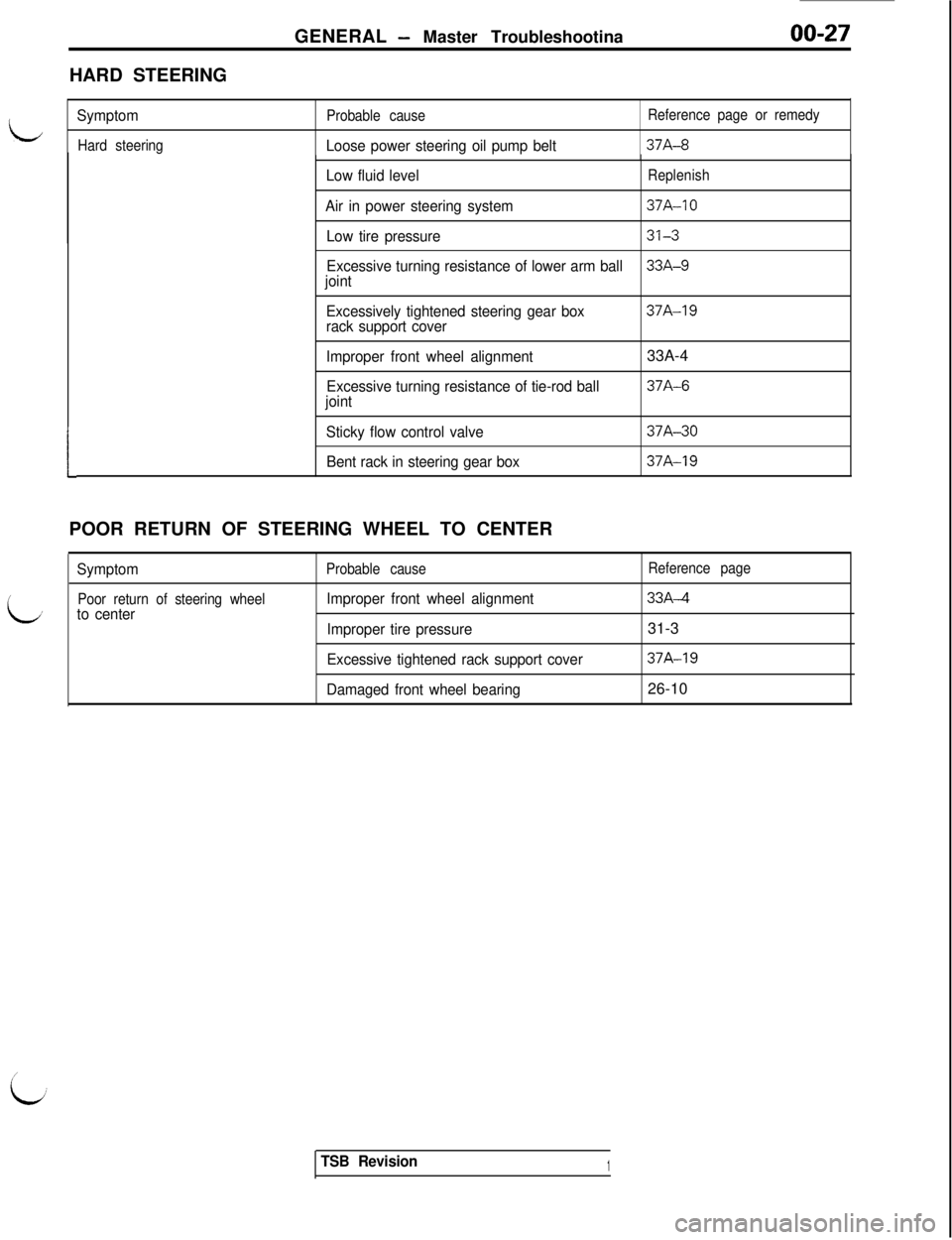
GENERAL - Master Troubleshootina00-27HARD STEERING
L
L
Symptom
Hard steeringProbable causeLoose power steering oil pump belt
Reference page or remedy37A-8
1POOR RETURN OF STEERING WHEEL TO CENTER
Symptom
Poor return of steering wheelto center
Probable cause
Improper front wheel alignment
Improper tire pressure
Excessive tightened rack support cover
Damaged front wheel bearing
Reference page33A-4
31-3
37A-1926-10
Low fluid levelReplenish
Air in power steering system37A-10
Low tire pressure
313
Excessive turning resistance of lower arm ball33A-9joint
Excessively tightened steering gear box
rack support cover
37A-19
Improper front wheel alignment
Excessive turning resistance of tie-rod ball
joint
Sticky flow control valve
Bent rack in steering gear box33A-437A-6
37A-30
37A-19
TSB Revision1
Page 32 of 1146
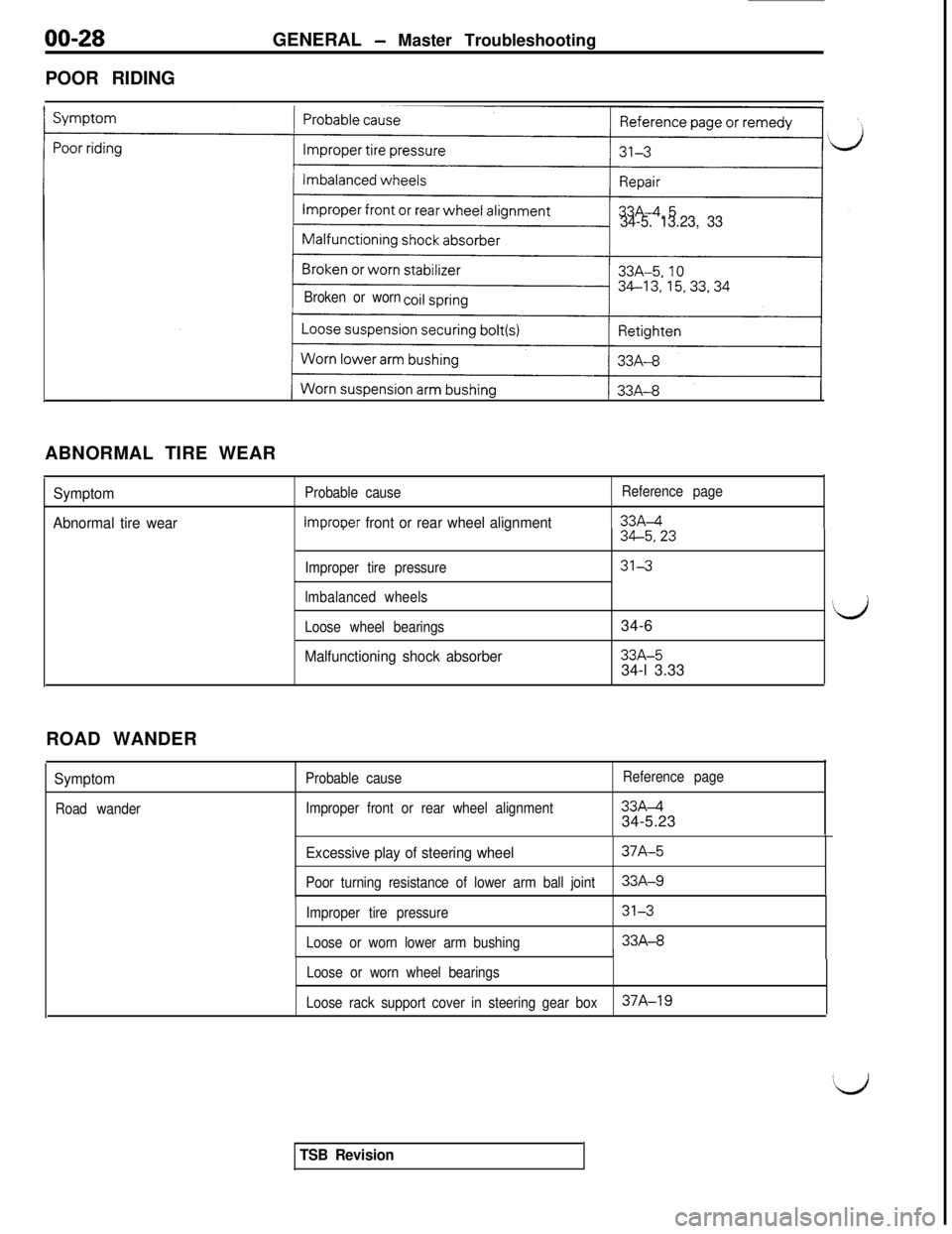
00-28GENERAL - Master Troubleshooting
POOR RIDING
34-5. 13.23, 33
Broken or wornABNORMAL TIRE WEAR
Symptom
Abnormal tire wearProbable cause
lmorooer front or rear wheel alignment, ,
Improper tire pressure
lmbalanced wheels
Loose wheel bearings
Malfunctioning shock absorber
Reference page
33Ad34-5,23
31334-6
LJ33A-5
34-l 3.33
ROAD WANDER
Symptom
Road wanderProbable cause
Improper front or rear wheel alignmentReference page33A&34-5.23
Excessive play of steering wheel
Poor turning resistance of lower arm ball joint37A-533A-9
Improper tire pressure
Loose or worn lower arm bushing31333A-8
III
Loose or worn wheel bearings
Loose rack support cover in steering gear box37A-19
TSB Revision
Page 33 of 1146
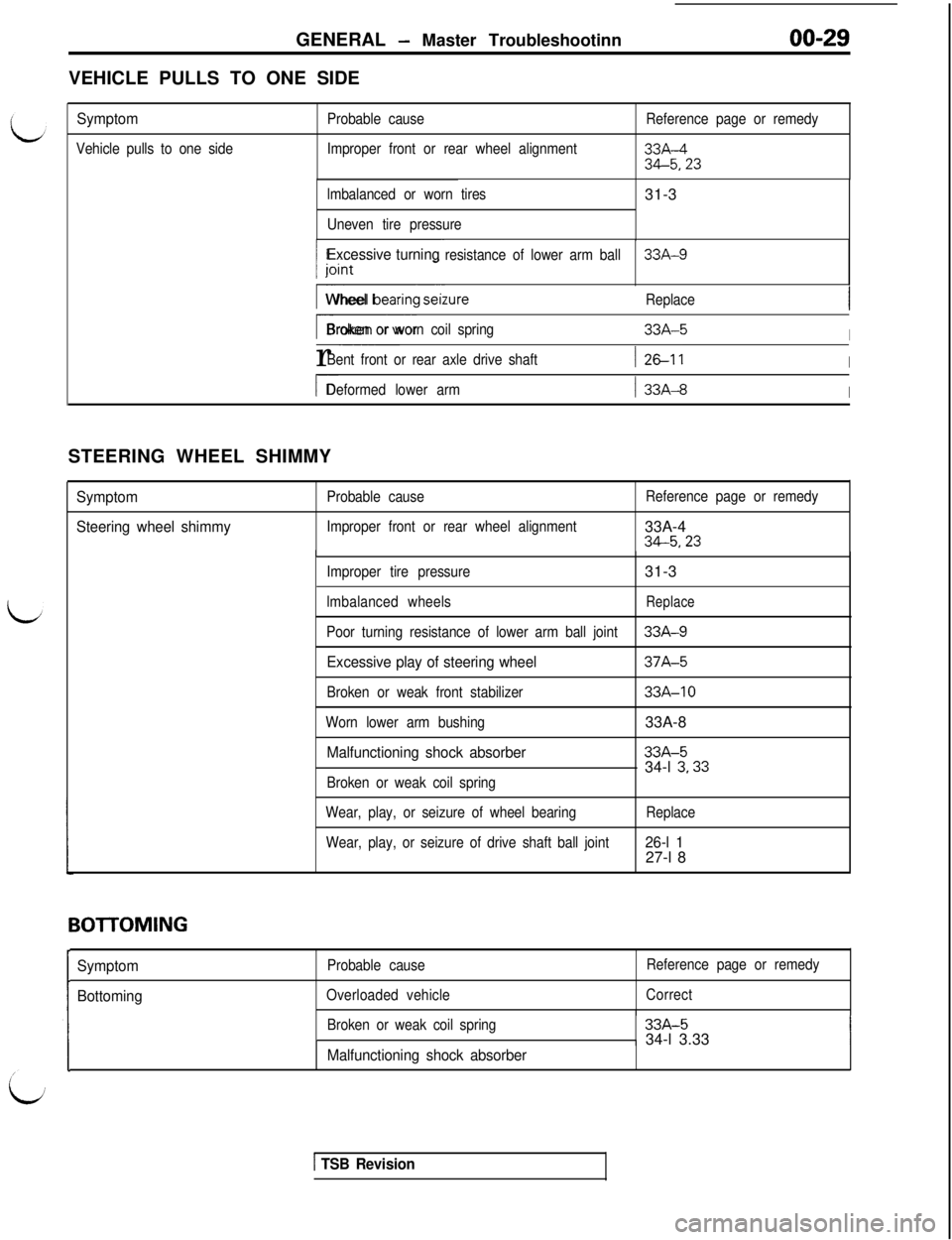
GENERAL - Master Troubleshootinn
VEHICLE PULLS TO ONE SIDE
Symptom
Vehicle pulls to one sideProbable cause
Improper front or rear wheel alignmentReference page or remedy33A-4
34-5,23
lmbalanced or worn tires
Uneven tire pressure31-3
Excessive turningresistance of lower arm ball33A-9
I--_Wheel beanng serzureReplace
I---Broken or worn coil spring33A-5Ir
~~~~~~Bent front or rear axle drive shaft126-11I
I-Deformed lower arm1 33A-8I
Improper tire pressure31-3
lmbalanced wheelsReplace
Poor turning resistance of lower arm ball joint33A-9
Excessive play of steering wheel37A-5
Broken or weak front stabilizer33A-10
Worn lower arm bushing33A-8
Malfunctioning shock absorber33A-5
34-l 3,33
Broken or weak coil spring
Wear, play, or seizure of wheel bearing
Wear, play, or seizure of drive shaft ball jointReplace
26-l 127-l 8 STEERING WHEEL SHIMMY
SymptomProbable cause
Steering wheel shimmyImproper front or rear wheel alignmentReference page or remedy33A-434-5,23
Boll-OMING
Symptom
BottomingProbable cause
Overloaded vehicleReference page or remedy
Correct
Broken or weak coil spring33A-5
34-l 3.33
IMalfunctioning shock absorber
1 TSB Revision
Page 34 of 1146
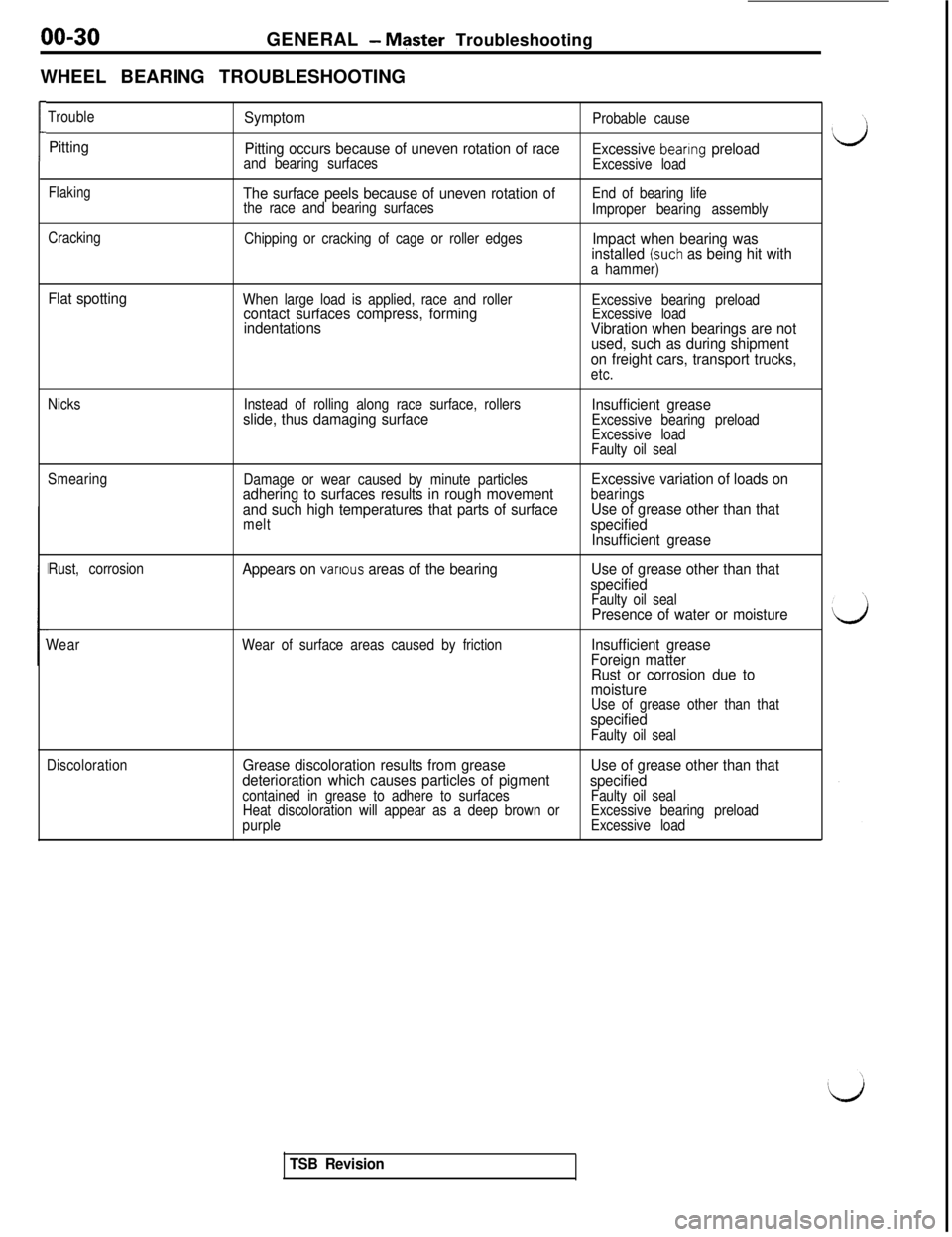
00-30GENERAL - Master Troubleshooting
WHEEL BEARING TROUBLESHOOTING
1
Trouble
PittingSymptom
Pitting occurs because of uneven rotation of race
and bearing surfacesProbable causeExcessive bearing preloadExcessive load
FlakingThe surface peels because of uneven rotation ofthe race and bearing surfacesEnd of bearing life
Improper bearing assembly
Cracking
Chipping or cracking of cage or roller edges
Impact when bearing was
installed (such as being hit witha hammer)
Flat spottingWhen large load is applied, race and rollercontact surfaces compress, forming
indentationsExcessive bearing preload
Excessive load
Vibration when bearings are not
used, such as during shipment
on freight cars, transport trucks,
etc.
NicksInstead of rolling along race surface, rollers
slide, thus damaging surfaceInsufficient greaseExcessive bearing preload
Excessive load
Faulty oil seal
Smearing
Damage or wear caused by minute particles
adhering to surfaces results in rough movement
and such high temperatures that parts of surface
melt
Excessive variation of loads onbearingsUse of grease other than that
specified
Insufficient grease
Rust, corrosionAppears on various areas of the bearingUse of grease other than that
specified
Faulty oil sealPresence of water or moisture
WearWear of surface areas caused by frictionInsufficient grease
Foreign matter
Rust or corrosion due to
moisture
Use of grease other than thatspecifiedFaulty oil seal
Discoloration
Grease discoloration results from grease
deterioration which causes particles of pigment
contained in grease to adhere to surfaces
Heat discoloration will appear as a deep brown or
purple
Use of grease other than that
specified
Faulty oil seal
Excessive bearing preload
Excessive load
TSB Revision
Page 35 of 1146
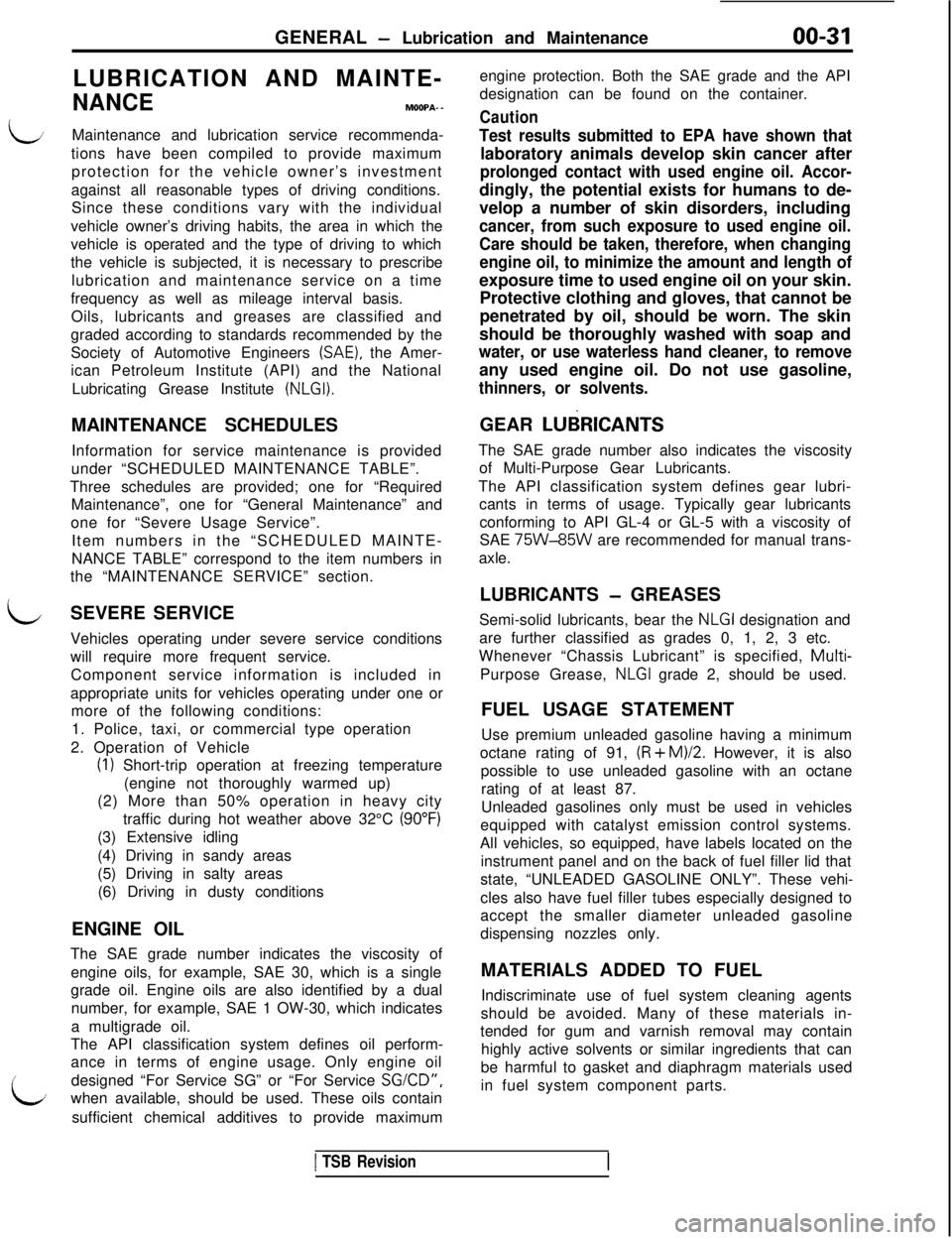
GENERAL - Lubrication and Maintenance00-31LUBRICATION AND MAINTE-
NANCEMOOPA- -
iiMaintenance and lubrication service recommenda-
tions have been compiled to provide maximum
protection for the vehicle owner’s investment
against all reasonable types of driving conditions.
Since these conditions vary with the individual
vehicle owner’s driving habits, the area in which the
vehicle is operated and the type of driving to which
the vehicle is subjected, it is necessary to prescribe
lubrication and maintenance service on a time
frequency as well as mileage interval basis.
Oils, lubricants and greases are classified and
graded according to standards recommended by the
Society of Automotive Engineers
(SAE), the Amer-
ican Petroleum Institute (API) and the National
Lubricating Grease Institute
(NLGI).MAINTENANCE SCHEDULES
Information for service maintenance is provided
under “SCHEDULED MAINTENANCE TABLE”.
Three schedules are provided; one for “Required
Maintenance”, one for “General Maintenance” and
one for “Severe Usage Service”.
Item numbers in the “SCHEDULED MAINTE-
NANCE TABLE” correspond to the item numbers in
the “MAINTENANCE SERVICE” section.
LSEVERE SERVICE
Vehicles operating under severe service conditions
will require more frequent service.
Component service information is included in
appropriate units for vehicles operating under one or
more of the following conditions:
1. Police, taxi, or commercial type operation
2. Operation of Vehicle
(1) Short-trip operation at freezing temperature
(engine not thoroughly warmed up)
(2) More than 50% operation in heavy city
traffic during hot weather above 32°C
(90°F)(3) Extensive idling
(4) Driving in sandy areas
(5) Driving in salty areas
(6) Driving in dusty conditions
ENGINE OIL
The SAE grade number indicates the viscosity of
engine oils, for example, SAE 30, which is a single
grade oil. Engine oils are also identified by a dual
number, for example, SAE 1 OW-30, which indicates
a multigrade oil.
The API classification system defines oil perform-
ance in terms of engine usage. Only engine oil
idesigned “For Service SG” or “For Service
SGXD”,when available, should be used. These oils contain
sufficient chemical additives to provide maximumengine protection. Both the SAE grade and the API
designation can be found on the container.
Caution
Test results submitted to EPA have shown thatlaboratory animals develop skin cancer after
prolonged contact with used engine oil. Accor-dingly, the potential exists for humans to de-
velop a number of skin disorders, including
cancer, from such exposure to used engine oil.
Care should be taken, therefore, when changing
engine oil, to minimize the amount and length ofexposure time to used engine oil on your skin.
Protective clothing and gloves, that cannot be
penetrated by oil, should be worn. The skin
should be thoroughly washed with soap and
water, or use waterless hand cleaner, to removeany used engine oil. Do not use gasoline,
thinners, or solvents.GEAR
LUEiRlCANTSThe SAE grade number also indicates the viscosity
of Multi-Purpose Gear Lubricants.
The API classification system defines gear lubri-
cants in terms of usage. Typically gear lubricants
conforming to API GL-4 or GL-5 with a viscosity of
SAE
75W-85W are recommended for manual trans-
axle.
LUBRICANTS
- GREASES
Semi-solid lubricants, bear the
NLGI designation and
are further classified as grades 0, 1, 2, 3 etc.
Whenever “Chassis Lubricant” is specified,
Multi-Purpose Grease,
NLGI grade 2, should be used.
FUEL USAGE STATEMENT
Use premium unleaded gasoline having a minimum
octane rating of 91,
(R + M)/2. However, it is also
possible to use unleaded gasoline with an octane
rating of at least 87.
Unleaded gasolines only must be used in vehicles
equipped with catalyst emission control systems.
All vehicles, so equipped, have labels located on the
instrument panel and on the back of fuel filler lid that
state, “UNLEADED GASOLINE ONLY”. These vehi-
cles also have fuel filler tubes especially designed to
accept the smaller diameter unleaded gasoline
dispensing nozzles only.
MATERIALS ADDED TO FUEL
Indiscriminate use of fuel system cleaning agents
should be avoided. Many of these materials in-
tended for gum and varnish removal may contain
highly active solvents or similar ingredients that can
be harmful to gasket and diaphragm materials used
in fuel system component parts.
1 TSB Revision
Page 36 of 1146
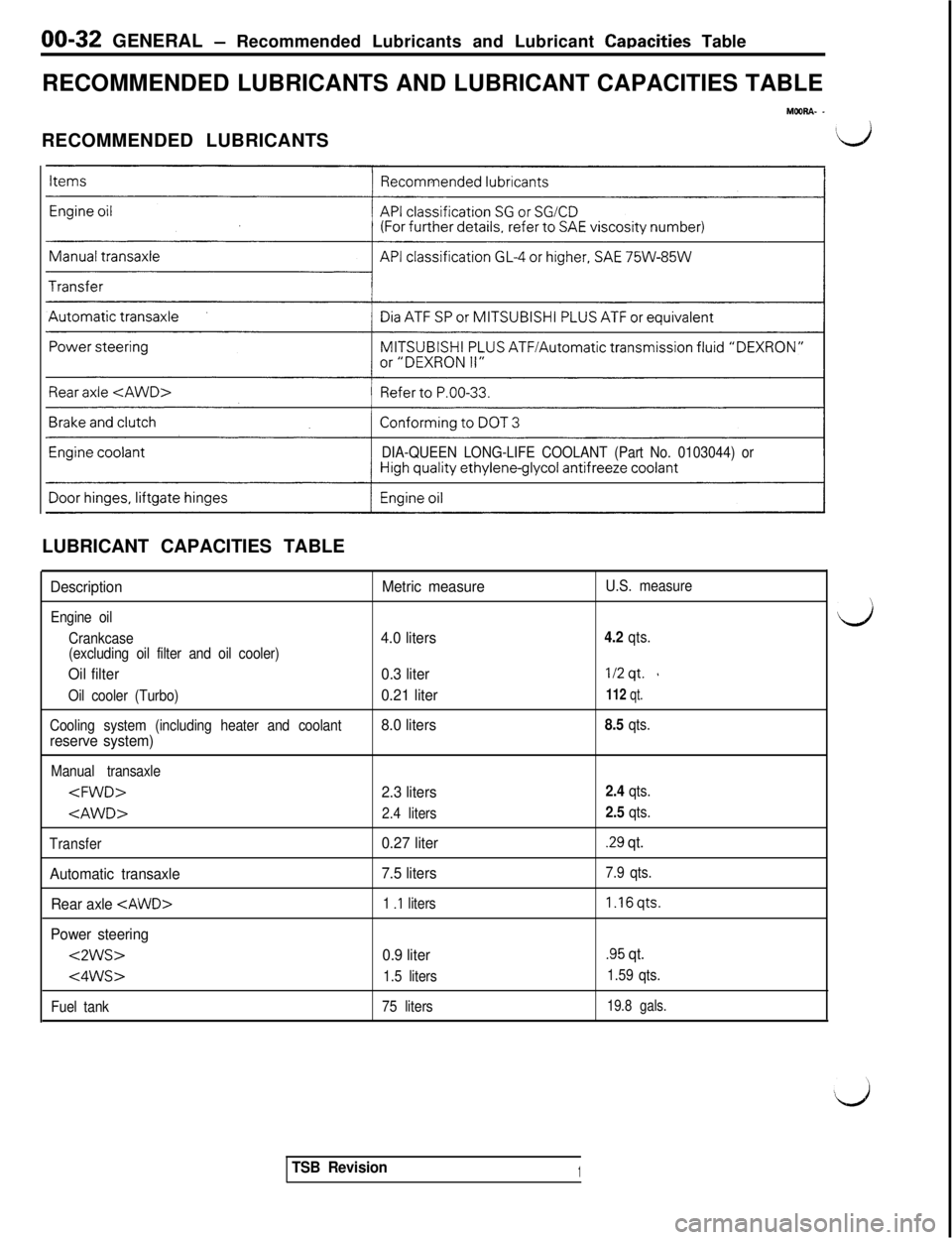
00-32 GENERAL - Recommended Lubricants and Lubricant Capacities Table
RECOMMENDED LUBRICANTS AND LUBRICANT CAPACITIES TABLE
MOORA- -RECOMMENDED LUBRICANTS
\L/
DIA-QUEEN LONG-LIFE COOLANT (Part No. 0103044) orLUBRICANT CAPACITIES TABLE
Description
Engine oil
Crankcase
(excluding oil filter and oil cooler)
Oil filter
Oil cooler (Turbo)
Cooling system (including heater and coolant
reserve system)
Manual transaxle
Transfer
Automatic transaxle
Rear axle
Power steering
<2ws>
<4ws>
Fuel tank
Metric measureU.S. measure
4.0 liters4.2 qts.
0.3 liter1/2qt. s
0.21 liter112 qt.
8.0 liters8.5 qts.
2.3 liters2.4 qts.
2.4 liters
2.5 qts.
0.27 liter.29 qt.
7.5 liters
7.9 qts.
1
.I liters1.16qts.
0.9 liter
.95 qt.
1.5 liters1.59 qts.
75 liters
19.8 gals.
TSB Revision1
d
Page 37 of 1146
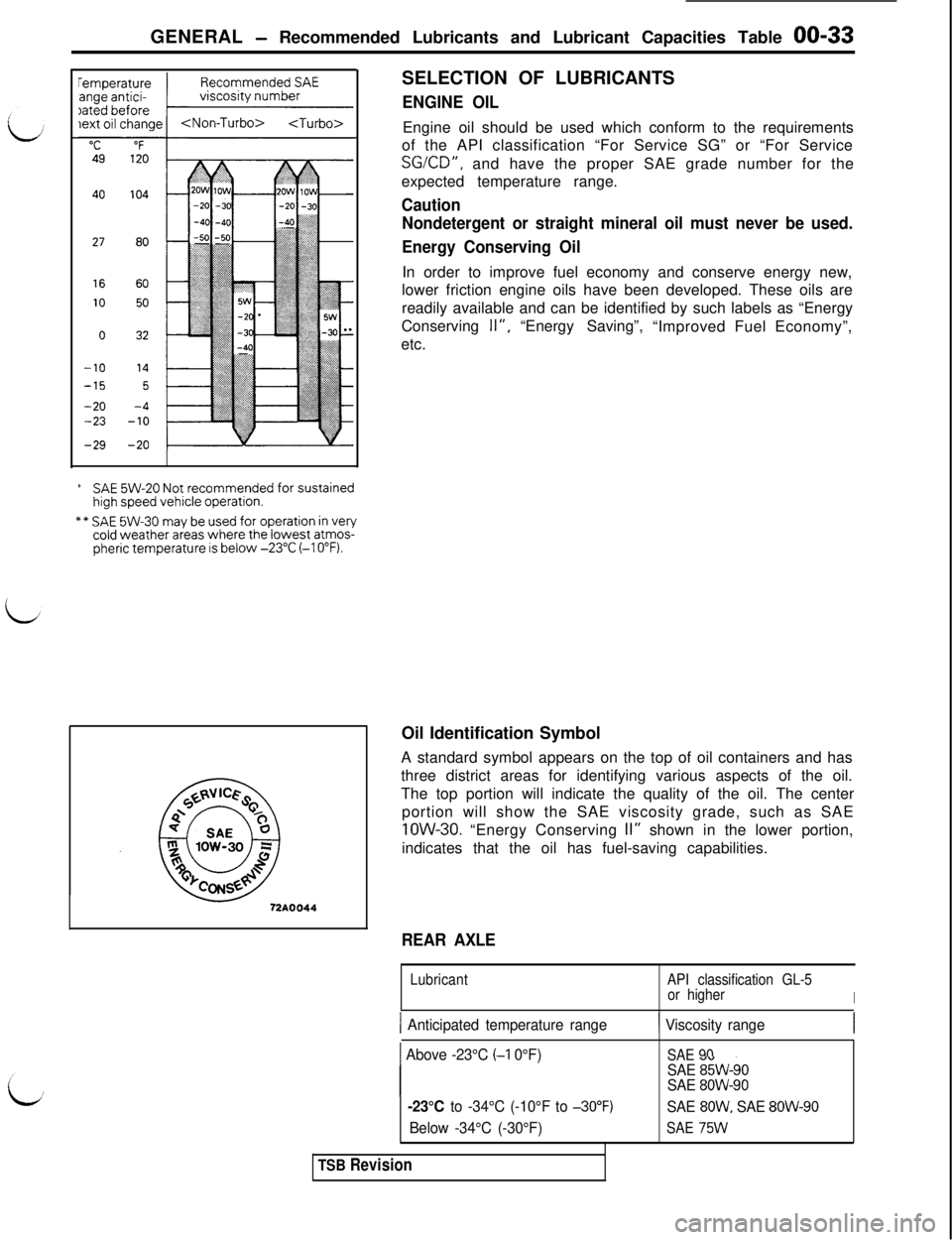
GENERAL - Recommended Lubricants and Lubricant Capacities Table 00-334027
8016
60
1050032
-1014
-155
-20-4-23-10
-29-20104
6SAE 5W-20 Not recommended for sustainedhigh speed vehicle operation.
** SAE 5W-30 may be used for operation in verycold weather areas where the lowest atmos-pheric temperature is below -23°C (-10°F).SELECTION OF LUBRICANTS
ENGINE OILEngine oil should be used which conform to the requirements
of the API classification “For Service SG” or “For Service
SGKD”, and have the proper SAE grade number for the
expected temperature range.
Caution
Nondetergent or straight mineral oil must never be used.
Energy Conserving OilIn order to improve fuel economy and conserve energy new,
lower friction engine oils have been developed. These oils are
readily available and can be identified by such labels as “Energy
Conserving
II”,“Energy Saving”,
“Improved Fuel Economy”,
etc.
Oil Identification Symbol
A standard symbol appears on the top of oil containers and has
three district areas for identifying various aspects of the oil.
The top portion will indicate the quality of the oil. The center
portion will show the SAE viscosity grade, such as SAEIOW-30. “Energy Conserving
II” shown in the lower portion,
indicates that the oil has fuel-saving capabilities.
72AOO.34
REAR AXLE
LubricantAPI classification GL-5
or higher
I
1 Anticipated temperature range
1 Above -23°C k-1 0°F)
1 Viscosity range
-23°C to -34°C (-10°F to -30°F)
Below -34°C (-30°F)
SAE 90SAE 85W-90SAE 8OW-90
SAE 80W. SAE 8OW-90
SAE 75W
TSB Revision
Page 38 of 1146
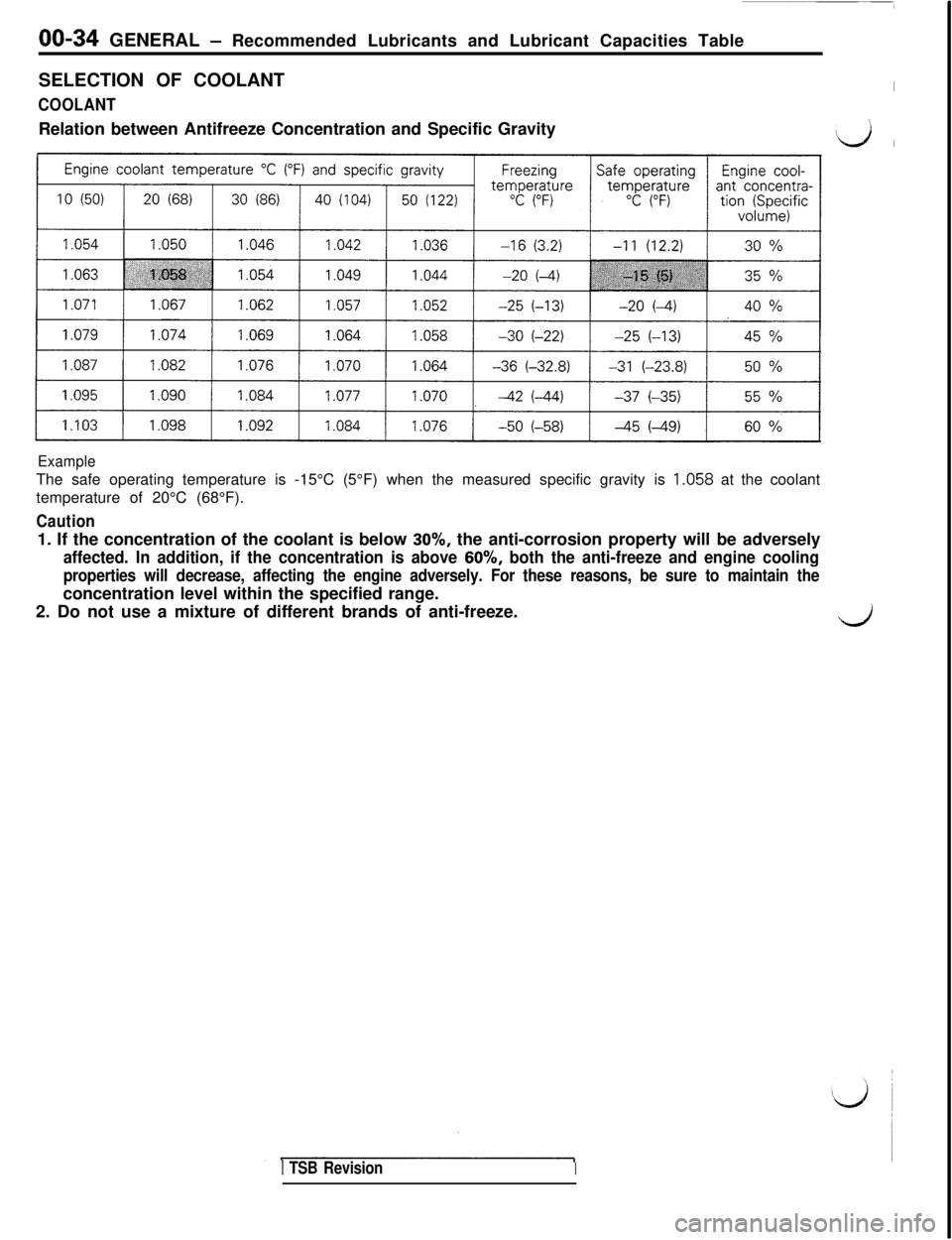
00-34 GENERAL - Recommended Lubricants and Lubricant Capacities Table
SELECTION OF COOLANT
COOLANTRelation between Antifreeze Concentration and Specific Gravity
I
\
‘d I
ExampleThe safe operating temperature is -15°C (5°F) when the measured specific gravity is 1.058 at the coolant
temperature of 20°C (68°F).
Caution1. If the concentration of the coolant is below 30%, the anti-corrosion property will be adversely
affected. In addition, if the concentration is above 60%, both the anti-freeze and engine cooling
properties will decrease, affecting the engine adversely. For these reasons, be sure to maintain theconcentration level within the specified range.
2. Do not use a mixture of different brands of anti-freeze.
-/‘.
1 TSB RevisionI
Page 39 of 1146
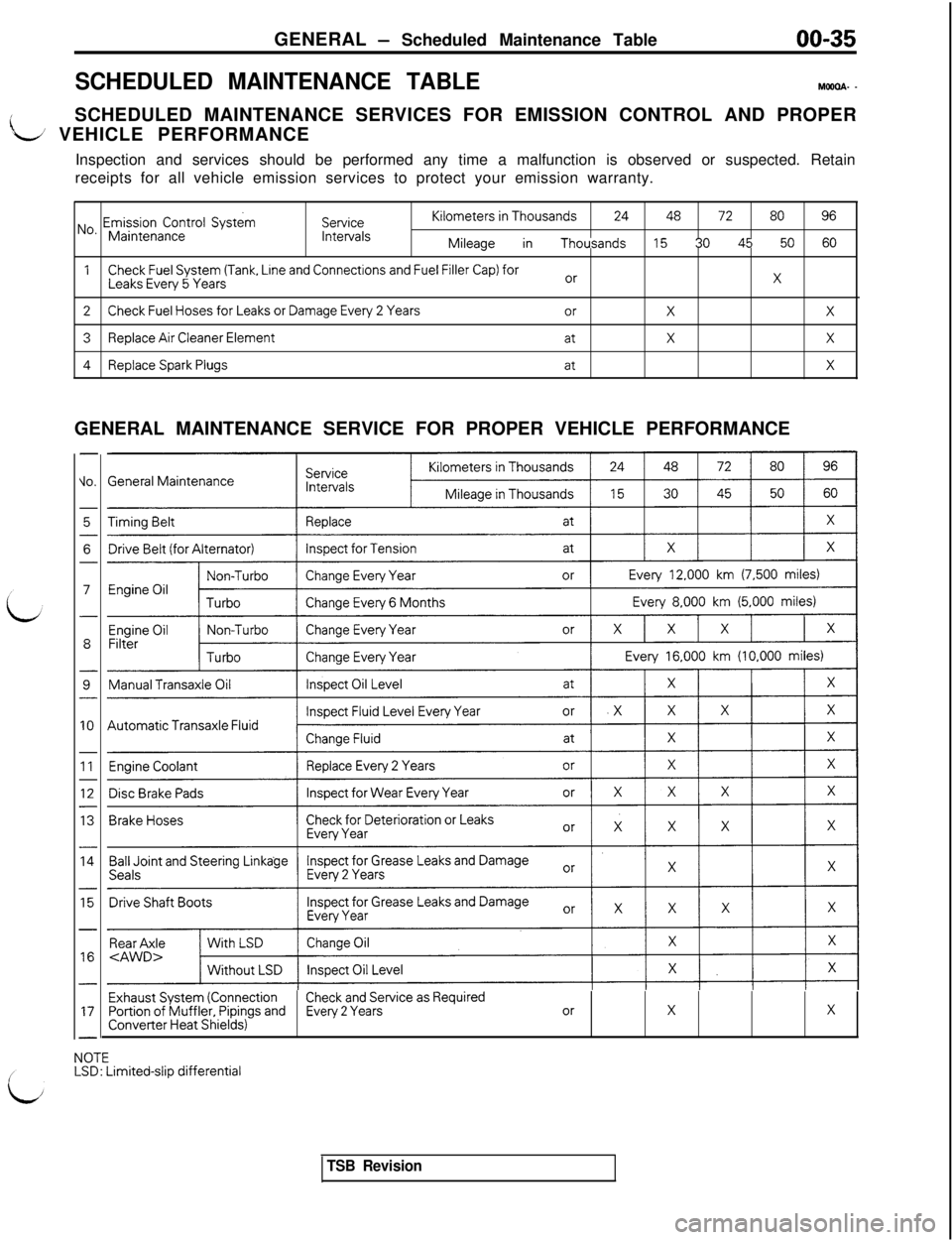
GENERAL - Scheduled Maintenance Table00-35
SCHEDULED MAINTENANCE TABLE
MOOOA- _SCHEDULED MAINTENANCE SERVICES FOR EMISSION CONTROL AND PROPER
L VEHICLE PERFORMANCE
Inspection and services should be performed any time a malfunction is observed or suspected. Retain
receipts for all vehicle emission services to protect your emission warranty.
No, Emission Control SystemServiceKilometersinThousands 24 48 72 80 96
MaintenanceIntervalsMileage in Thousands 15 30 45 50 60
1Check Fuel System (Tank. Line and Connections and Fuel Filler Cap) forLeaks Every 5 Yearsorx
2Check Fuel Hoses for Leaks or Damage Every 2 YearsorXX
3Replace Air Cleaner ElementatXX
4Replace Spark PlugsatXGENERAL MAINTENANCE SERVICE FOR PROPER VEHICLE PERFORMANCE
-
10.
-
5-
6-
7
-
8
-
9-
10
-
11-
12-
13
-
14
-
15
-
16
-
17
-
General Maintenance
Automatic Transaxle Fluid
Exhaust System (ConnectionCheck and Service as RequiredPortion of Muffler, Pipings andEvery 2 YearsorXXConverter Heat Shields)
NOTELSD: Limited-slip differential
TSB Revision
Page 40 of 1146
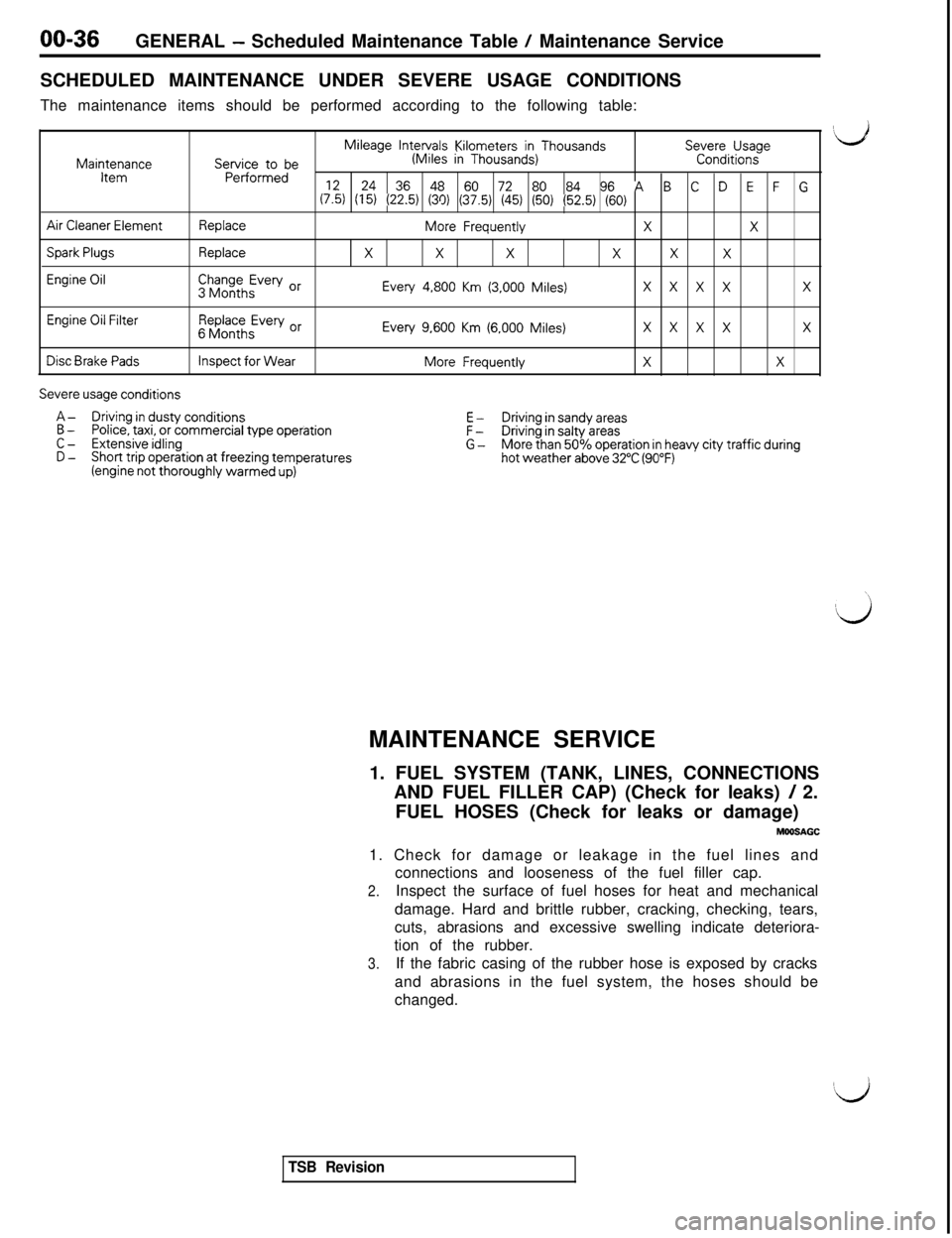
00-36GENERAL - Scheduled Maintenance Table / Maintenance Service
SCHEDULED MAINTENANCE UNDER SEVERE USAGE CONDITIONS
The maintenance items should be performed according to the following table:
Mileage Intervals Kilometers in ThousandsSevere Usage
MaintenanceService to be(Miles in Thousands)Conditions
itemPerformed
(6 (15) (22.5) (30) (37.5) (45) (50) (52.5) (60)24 36 48 60 72 80 84 96 A B C D E F G
Air Cleaner ElementReplaceMore FrequentlyXX
Spark PlugsReplaceXXXXXX
Engine OilChange Every Or3 MonthsEvery 4,800 Km (3,000 Miles)x x x xX
Engine Oil FilterReplace Every or6 MonthsEvery 9,600 Km (6.000 Miles)x x x xX
Disc Brake PadsInspect for WearMore FrequentlyXX
Severe usage conditions
A-Driving in dusty conditionsE -B -Police, taxi, or commercial type operationF -Driving in sandy areas
C -Extensive idlingG -Driving in salty areas
D -Short trip operation at freezing temperaturesMore than 50% operation in heavy city traffic during
(engine not thoroughly warmed up)hot weather above 32°C (90°F)MAINTENANCE SERVICE
1. FUEL SYSTEM (TANK, LINES, CONNECTIONS
AND FUEL FILLER CAP) (Check for leaks)
/ 2.
FUEL HOSES (Check for leaks or damage)MWShGC
1. Check for damage or leakage in the fuel lines and
connections and looseness of the fuel filler cap.
2.Inspect the surface of fuel hoses for heat and mechanical
damage. Hard and brittle rubber, cracking, checking, tears,
cuts, abrasions and excessive swelling indicate deteriora-
tion of the rubber.
3.If the fabric casing of the rubber hose is exposed by cracks
and abrasions in the fuel system, the hoses should be
changed.
TSB Revision